by Shaila Palamand

This often-overlooked migrating songbird is worth a note, or maybe even a harmonic series of notes!
The Hermit Thrush may not have brightly colored plumage or gregarious social behavior like many popular songbirds, but it has other endearing qualities that can make it a delight to observe. In particular, the Hermit Thrush is famous for its incredible singing voice, a sound so beautiful that it has served as an inspiration for poets and other artists for hundreds of years.
Like its namesake, the Hermit Thrush generally behaves in a solitary manner. On the other hand, this bird has also been nicknamed the “American nightingale” due to its amazing vocal abilities.
The song of the Hermit Thrush is a sweet whistling tune, almost flute-like, with harmonic notes similar to the scales used in human music compositions. This rich sound was the basis for several works by classical composer and pianist Amy Beach, as well as writings by poets such as Walt Whitman and T.S. Eliot. The Hermit Thrush has also been appreciated by contemporary artists, such as the Canadian alternative band “Thrush Hermit.”
Typically, this songbird arrives in Texas in the fall and departs around April or May. However, in the Piney Wood Lakes area, flowers are already blooming, leaves are popping, and pollen is dropping; in short, it seems that spring has arrived early this year. At the time of writing, the Hermit Thrush is still here, taking advantage of all the delicious insects, spiders and worms that have emerged with the season. But an early start of spring might mean an early end, and if so, this migrant may soon head back north to its breeding grounds.
If you can’t hear one singing, look for the Hermit Thrush on the forest floor foraging for insects in the dense brush, or at the edge of a clearing. At a glance, it might look like a plain grayish-brown bird; but look a little closer, and you’ll see its white eye ring, pink legs, white breast with brown triangle-shaped spots, and signature reddish-brown tail. Although they tend to move quickly, their tail coloring and spots make them slightly easier to identify than other thrush species, especially at this time of year. (The Hermit Thrush is the only spotted thrush that stays in North America for the winter.)
And if you miss them this season, don’t despair – they’ll be back in the fall!
In the meantime, enjoy this excerpt from Walt Whitman’s “When Lilacs Last in the Dooryard Bloom’d”:
In the swamp in secluded recesses,
A shy and hidden bird is warbling a song.
Solitary the thrush,
The hermit withdrawn to himself, avoiding the settlements,
Sings by himself a song.



